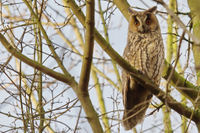Long-Eared Owl
 From Conservapedia
From Conservapedia | Long-eared Owl | |
|---|---|

| |
| Scientific classification | |
| Kingdom Information | |
| Domain | Eukaryota |
| Kingdom | Animalia |
| Subkingdom | Bilateria |
| Branch | Deuterostomia |
| Phylum Information | |
| Phylum | Chordata |
| Sub-phylum | Vertebrata |
| Infraphylum | Gnathostomata |
| Class Information | |
| Superclass | Tetrapoda |
| Class | Aves |
| Sub-class | Neornithes |
| Infra-class | Neoaves |
| Order Information | |
| Order | Strigiformes |
| Family Information | |
| Family | Strigidae |
| Sub-family | Striginae |
| Genus Information | |
| Genus | Asio |
| Species Information | |
| Species | A. otus |
| Population statistics | |
| Population | 2,180,000-5,540,000 est. (2015) |
| Conservation status | Least concern[1] |
The long-eared owl (Asio otus) is a medium-sized owl of the family Strigidae, found in the woodlands throughout much of the Northern Hemisphere.
Description[edit]
The long-eared owl is about 12–16 inches long, with a wingspan of 34–39 inches, weighing between 6.3 and 15.3 ounces. Females are larger than males. The upper plumage is a yellow rust brown to grayish-brown (females are somewhat darker), mottled with black spots and stripes. Chest and belly are a pale yellow to cream, and bearing dark vertical stripes. The facial disk is brown, with a light greyish "V" mark centered between the yellow-orange eyes, and extending downwards on either side of the beak. The brown ear tufts are set more in towards the center of the face, directly over the eyes; their length sets it immediately apart from the similar short-eared owl, with which it shares much of its range.
Subspecies[edit]
- Asio otus canariensis; Canary Islands.
- Asio otus otus; Europe, northern Africa, Azores Islands, eastward to central and northern Asia.
- Asio otus tuftsi; western North America: Canada southward to Mexico.
- Asio otus wilsonianus; eastern North America: Canada southward to Oklahoma and Virginia.
References[edit]
Categories: [Birds] [Birds of Prey] [Owls] [Eared Owls]
↧ Download as ZWI file | Last modified: 02/14/2023 03:21:23 | 5 views
☰ Source: https://www.conservapedia.com/Long-eared_owl | License: CC BY-SA 3.0
 ZWI signed:
ZWI signed: KSF
KSF